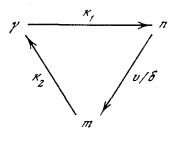Institute of Biological Physics of the Academy of Sciences of the USSR,
Pushchino, USSR
(Received 1 July 1975, and in revised form 24 March 1976)
The widely accepted steric model of calcium regulation of actin-myosin interactions in vertebrate muscles has to be completed to fit the kinetic data. It should be supposed that: (1) the thin filaments consist of functionally independent units, containing seven actin sites regulated by one troponintropomyosin complex; (2) actin sites become available for myosin heads only due to fluctuations of tropomyosin position; (3) binding of calcium to troponin results either in the shift of the tropomyosin equilibrium position or in the weakening of its interactions with actin strand so that the probability of effective fluctuations increases; (4) link formation between myosin head and some of the available actin site fixates the tropomyosin in such a position that the other six actin sites of the same functional unit become available for myosin too.
The model gives linear kinetic scheme for the transitions of a functional unit between nine states (a “turned off” state, and eight “turned on” ones with different occupancy by myosin heads). The dependences of the apparent rate constants of actomyosin formation and dissociation upon the myosin head and substrate concentrations are obtained from the Lymn-Taylor scheme. The frequency of the actomyosin complexes dissociation is assumed to give the ATPase rate.
The model fits the kinetic data on the ATP hydrolysis by myosin subfragment-1 with regulated or unregulated actin as a cofactor under various conditions. It shows a sharp dependence of activation upon the apparent affinity of the actin and myosin sites. Therefore, the model appears to be applicable to myosin controlled systems.
